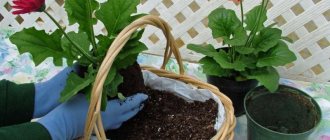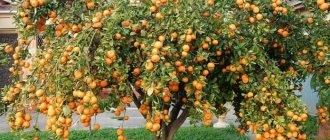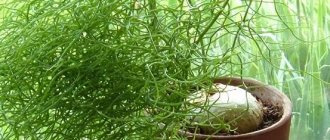Gardening » Citrus » Lemon
0
1204
Article rating
Kira Stoletova
Lemon blossoms are a mesmerizing sight. The plant smells amazing. After flowering, the first fruit begins to set. In order for it to ripen, you will have to do a lot of work and provide citrus care.
lemon blossom
Brief description of cultivation
- Bloom . In indoor conditions, a lemon tree can bloom at different times of the year.
- Illumination . This culture grows and develops well in short daylight hours. It is recommended to place the tree on a window with an eastern or western orientation; in the afternoon, when the sun is most active, it should be shaded from direct rays. In order for the crown of the tree to be symmetrical, it should be regularly rotated 10 degrees around its axis (in one direction) once every week and a half. In winter, the plant needs additional lighting for 5–6 hours every day.
- Temperature regime . During the growing season - about 17 degrees, during the formation of buds - no higher than 14-18 degrees, during the period of active fruit growth - from 22 degrees. In winter, the bush is kept in a cool place - from 12 to 14 degrees.
- Watering rules . From May to early autumn, lemons are watered every day. After this, the soil in the pot needs to be moistened no more than once every 3-4 days.
- Air humidity . The plant needs to systematically spray the foliage from a spray bottle with pre-boiled water, the temperature of which is slightly higher than room temperature. The bush should be moistened most often on hot summer days and in winter if the lemon is in a room where there are working heating devices.
- Fertilizer . Such a tree is fed with complex mineral fertilizer, and it must be added to the substrate throughout the entire growing season. Adult bushes are fed once every 20–30 days, and young bushes - once every 6 weeks. From the second half of the autumn period, a gradual reduction in the frequency of fertilizing is required: if the lemon is in a cool room at rest, then it is not fed at all, and if it is in a warm room, fertilizers are added to the soil mixture periodically once every 6 weeks. Feed the plant with a nutrient solution only after preliminary watering.
- Rest period . In winter, it is not pronounced.
- Transplant . In spring, at the very beginning of the growing season. A young plant is subjected to this procedure once every 1–2 years. An adult tree is replanted only when the root system becomes crowded in the container and the roots appear from the drainage holes.
- Reproduction methods . Seed method, grafting and cuttings.
- Pests . Whiteflies, mealybugs, spider mites, common and root aphids, scale insects.
- Diseases . Tristeza, homo blight, anthracnose, root rot, chlorosis, citrus canker, scab, leaf mosaic virus and melseco.
Diseases and pests
Indoor lemon is susceptible to viral, bacterial, fungal infections, and pests also live on it.
| Name of disease/pest | Signs | Causes | Treatment |
| Gomoz | Brown spots on the trunk and branches, then the bark dies. A golden sticky liquid emerges from the cracks and hardens in air. | Cortical injuries. Overwatering of soil, lack of potassium and phosphorus, excess nitrogen | Cut off all affected areas and branches, treat the wounds with a 3% solution of copper sulfate, cover with garden varnish |
| Root rot | Dropping leaves. No damage is visible visually. You need to get the plant out and inspect the roots | Remove diseased roots and plant in fresh soil. Place in the sun, stop watering for a week, just wipe the leaves with a damp sponge | |
| Sooty fungus | Stems and leaves darken, black spots appear | The result of the appearance of a pest is scale insects. It secretes a sugary liquid on which a black fungus settles. | Soap solution (2 tablespoons of liquid soap per liter of water), wipe the entire plant. After an hour, rinse. Repeat after 2 days. Garlic broth, insecticide solution. Systematic rinsing of foliage with clean cold water |
| Scab | Putrid spots on young foliage and branches. The plant drops its fruits | Fungus | Trimming all affected parts. Spraying the crown with 1% Bordeaux mixture |
| Anthracnose | Yellowing, falling leaves, drying out branches. Red spots on fruits | Fungus | Removing dead branches. Spraying the tree three times with Fitosporin or a 1% solution of Bordeaux mixture |
| Tristeza | Leaves fall, bark dies | The virus affects weak lemons that are not cared for | There is no treatment, the plant dies |
| Sheet mosaic | Dark or light stripes on the leaves. Then their deformation, stopping the development of the lemon | There is no treatment. You can reduce the manifestations with regular feeding | |
| Citrus cancer | Brown spots of various shapes on leaves and fruits. The fruits become distorted and the tree dies | It is impossible to cure. For prevention: spring treatment with liquid copper fungicide | |
| Root and common aphids | Foliage drying out, curling | Pest | Removing affected leaves. Spraying with a decoction of garlic peels and insecticides. Complex feeding. Transplantation into new soil |
| Spider mite | Curling leaves, cobwebs | Dry indoor air | A solution of 1% boric acid. Requires up to 5 sprays |
| Melseko | The shoots dry out, the foliage falls off starting from the ends of the branches. The broken branch is painted red | Lack of lighting. In winter there was not enough light, the plant was not illuminated | There is no treatment, only observation. If no improvement is visible, the plant is destroyed. |
Features of homemade lemon
The indoor lemon tree is a low-growing evergreen plant that is a perennial. Its powerful branches are covered with thorns. Young shoots have a violet-purple color on the upper part. The green leaf blades are leathery to the touch, have an oblong-oval shape, and have teeth on their edges. On the surface of the foliage there are many glands, inside of which there is essential oil. The lifespan of one leaf plate is from two to three years.
The process of bud formation takes approximately 35–40 days. Moreover, after opening, the flower does not fade for 7–9 weeks. A very pleasant aroma emanates from a flowering tree. More than nine months can pass from the formation of the ovaries to the full ripening of the fruit. The homemade lemon has an ovoid fruit shape, with the nipple located at the top. It is covered with a yellow peel, the surface of which is tuberous or pitted. The fruit emits a sharp, specific aroma characteristic of lemons. The juicy pulp is divided into 9–14 segments, it is colored yellowish-green and has a sour taste. Inside the fruit lobules there are several white, ovoid, irregularly shaped seeds. On top they are covered with a parchment shell, which is highly dense.
CARE AND MISTAKES WHEN GROWING LEMON
Application
The lemon tree is valued not only for its fruits. Lemon inflorescences are actively used in cooking and folk medicine. Lemon flowers are used in cooking not only as decoration. In the East they are used in making desserts. Floral lemon water is popular in Europe. It is used as a base for various cocktails.
In folk medicine, lemon blossoms are used:
- For insomnia and menstrual pain.
- For hypertension and emotional agitation.
- For nausea and stomach pain.
- When coughing.
Lemon trees are not only beautiful ornamental plants. With proper care of lemon, you can achieve regular flowering and fruiting. Flowering will provide a pleasant aroma in the room, the inflorescences can be used in cooking or medicine, and the ripe fruits can be eaten. The effort put into growing lemons is well worth it in terms of its beauty and fruits.
If you find an error, please select a piece of text and press Ctrl+Enter.
Lemons are favorite plants for growing on windowsills for many gardeners. Lemon blossoming is a rather unusual period, because a fresh, sweetish aroma with notes of anise and honeysuckle spreads throughout the room. For a tree to bloom, it will take a lot of effort, but even more to preserve the ovary.
Lemon blooms with beautiful fragrant flowers
Indoor lemon from seed
Features of propagation by seeds
Growing homemade lemon from seeds is quite simple. At the same time, you won’t have to look for seed material for a long time, since the seeds can be taken from fruits purchased in a regular store. To do this, you should choose a well-ripened fruit, the color of which should be uniform and yellow. In this case, you should choose those seeds that are well formed and fully matured.
To plant seeds, you should prepare a certain soil mixture. To do this, take a ready-made flower soil mixture purchased in a store and combine it with peat (1:1). In this case, the finished substrate should be light and well-drained, and its pH should be from 6.6 to 7.0.
How to plant a lemon
Take a small container and make a good drainage layer at the bottom. Then fill it with the prepared soil mixture. Remove the seeds from the fruit and immediately bury them 10–20 mm into the soil mixture. Place the container in a well-lit place, the optimal air temperature is from 18 to 22 degrees. Make sure the substrate is slightly damp at all times. The first shoots should appear about half a month after sowing.
Seedling care
To water lemon seedlings emerging from seeds, use water whose temperature should be close to room temperature. Do not forget to regularly loosen the surface of the substrate in pots, and this must be done very carefully. After the seedlings have formed 2 true leaf blades, the most developed and strong plants are selected and planted in individual pots up to 10 centimeters in diameter. Don’t forget to cover them with a glass jar on top to maintain the microclimate necessary for better rooting. Seedlings are provided with daily ventilation; for this, the shelter should be removed from them once a day for a short time. The next transplant into larger containers is carried out only after the height of the seedlings is 15–20 centimeters. The bushes should be replanted very carefully, trying to keep the lump of earth intact. The transshipment method is perfect for this.
When choosing a new pot, remember that it should be approximately 50–60 mm larger in diameter than the old one. If you take a larger container, then moisture will begin to accumulate in the substrate, which is not occupied by roots, which will lead to its souring. Make a good drainage layer at the bottom of the container; for this you can use pieces of polystyrene foam, expanded clay, pebbles or charcoal. For replanting, you can take a ready-made flower soil mixture purchased at a specialized store, or garden soil mixed with a small amount of humus is also suitable. When replanting a bush, make sure that its root collar remains at the same level as in the old pot. If it is buried, this may cause rot to appear on it.
HOW TO GROW A LEMON FROM A SEED VIDEO RECIPE
Lemon transplantation using the transshipment method
The transshipment method does not require a complete replacement of the soil, but involves transplanting the plant along with the old earthen ball into a new container. To do this, you need to carefully remove the plant from the pot along with the soil and inspect the roots. If they stick out noticeably in different directions, then the new pot should be larger than the previous one. If they intertwine at the bottom, then the same size is enough.
In a new pot, you need to fill the bottom with coarse coarse sand, then add a small layer of earth, and then place the lemon there along with the old lump of earth. At the end you need to level the soil and fertilize it.
This is best done at the end of February, shortly before the plant has entered the active growth phase, but after a period of deep winter hibernation.
Lemon care at home
Growing lemon indoors is quite difficult, but the grower will be generously rewarded for his efforts. The first thing you need to pay attention to is creating suitable conditions for this plant.
Illumination
As mentioned above, the lemon tree is a short-day plant. Therefore, it tolerates a lack of light quite well. If the daylight hours are long, this may cause the lemon tree to actively grow, but this may result in a delay in fruiting.
This culture feels best on a window with an eastern or southern orientation. But do not forget to protect the bush from the scorching rays of the sun in the afternoon. To keep the crown neat and attractive, you should rotate the tree around its axis by 10 degrees once every 1.5 weeks. If the bush is kept warm in winter and has active growth, then it should be provided with daily additional lighting of 5 to 6 hours.
Temperature
During intensive foliage growth, it is recommended that the tree be kept cool (about 17 degrees). During budding, the plant feels comfortable at an air temperature of 14 to 18 degrees. If the room is warmer, this may cause the buds and ovaries to fly around. But during the period of active growth, it is recommended to move the tree to a warmer place (from 22 degrees and above). Once the weather is warm outside, the plant can be moved to the balcony, garden or terrace. However, be careful, because the tree reacts negatively to sudden changes in temperature. That is why it is recommended to cover it or wrap it up every evening, and remove the cover in the morning.
In winter, the best temperature for a lemon tree is 12–14 degrees. Moreover, it is placed away from operating heating appliances. In this case, the plant will be able to enter a state of rest and have a good rest before the next growing season.
Watering the lemon
Homemade lemon should be watered every day from May to early autumn. At other times, you need to moisten the soil mixture approximately once every 3-4 days. When watering, the soil mixture should be well saturated with moisture, and before the next moistening, its surface must dry out slightly.
Water suitable for irrigation should sit well (at least 24 hours), but it is better to pass it through a filter. Its temperature should be close to room temperature. Make sure that there is no stagnation of water in the soil mixture. If the roots of the tree regularly suffer from stagnation of moisture in them, then an urgent replanting with a complete replacement of the soil mixture may be required.
Air humidity
Indoor lemon needs regular moistening of the foliage with a spray bottle. Moreover, the water must be boiled and warm in advance. If in winter the bush is warm, and even in a room where the air is dry from operating heating devices, then its foliage should be sprayed more often. But do not overdo it, because excess moisture can cause fungal disease to develop. If in winter the plant is dormant and stands in a cool place, then it does not need to be moistened.
Feeding
Indoor lemon requires systematic feeding. Complex mineral fertilizers are excellent for this. While the bush is young, fertilizer is added to the soil mixture regularly once every 6 weeks. An adult tree needs more frequent feeding: in spring and summer, the nutrient mixture is applied to the soil once every 15–20 days. A couple of hours before fertilizing, the soil mixture in the pot should be well moistened with ordinary water suitable for irrigation.
From the second half of October, feeding must be reduced. If in winter an adult tree is still growing as actively as in summer, then it should be fed once every 4–6 weeks. However, if it is at rest, then there is no need to add fertilizer to the soil mixture.
Among organic matter, the lemon tree responds best to fertilizing with ash extract, as well as infusion of fresh manure, which is diluted with water in a ratio of 1:5 or 1:6. An infusion of birch or quinoa leaves is also suitable. To prepare it, fill a glass jar ½ part with finely chopped leaves, then pour in enough water to keep the container full. The product will be ready after two or three days. Organic fertilizers should be added to the soil mixture at the same frequency as the mineral complex.
Flower growers often have this problem: the tree actively grows green mass and does not set fruit. In this case, the fertilizer should be replaced. It should contain a minimum of nitrogen and a maximum of phosphorus.
Lemon trimming
Homemade lemons need to be trimmed systematically. Its crown can be formed in different ways, depending on what it is grown for. If it is needed only to decorate the room, then the crown is formed in such a way that it is small and compact. However, if you want to get fragrant fruits from the tree, then its crown is formed differently.
A fruiting tree must be left with a certain number of main branches and growing shoots. Moreover, most of these shoots should be from fruit wood.
To give the crown the correct shape, you should resort to the pinching method. When the first zero shoot reaches a length of 20 to 25 centimeters, it will need to be pinched. After some time, the shoot is pinched, retreating from the old pinching from 15 to 20 centimeters. At the same time, pay attention to the fact that between the two pinches on the shoot there should be four well-developed buds. After some time, 3 or 4 main stems will appear from them, which should grow in different directions.
Pinching of the first order stems is carried out after 20–30 centimeters. And upon completion of the ripening of these shoots, they will need pruning, and they will need to move down about 50 mm from the pinching point. You should also remember that each previous stem should be approximately 50 mm longer than the next one. The formation of the crown needs to be completed on shoots of the fourth order.
If pruning is not carried out, then the tree will grow very long branches, while the formation of third- and fourth-order stems will be postponed for an indefinite period of time, namely, ovaries are formed on them, and later fruits grow.
Lemon trees are pruned not only to form a crown, but also for sanitary purposes. In this case, you need to cut out all weakened branches, as well as those directed inside the crown.
How to shape indoor lemon and other citrus fruits
What to do and how to make the plant produce buds?
If a lemon tree does not bloom for a long time, it can be provoked to bloom using proven methods:
- Creating extreme conditions:
- In winter, lemon can be taken out to the balcony to force the plant to wake up.
- The second way to change conditions is to deliberately create a period of drought, which is replaced by abundant watering.
- Crown formation. Lemon trees begin to bloom and bear fruit on branches of 3-4 orders. By molding you can push the plant to actively branch and the appearance of the necessary branches. It is important to do the molding correctly and not cut short fruit branches. In addition, pinching helps to form a beautiful crown of the tree.
- Pulling branches. By improvising with rope and weights, you can give the branches a horizontal position. This leads to faster flowering and fruiting. Skeletal branches can be tied with wire.
- Necessary care measures. The plant is needed:
- Feed in a timely manner (only in the summer season).
- Water with settled water.
- Spray frequently to create comfortable conditions that allow the lemon tree to grow stronger and gain strength for flowering.
We invite you to watch a video on how to help a lemon bloom:
Possible problems
Lemon turns yellow
Often gardeners are faced with the problem of yellowing of homemade lemons. This can happen for a variety of reasons, for example:
- the tree needs urgent feeding;
- a spider mite has settled on the plant;
- the air humidity in the room is excessively low;
- During wintering the bush is in a very warm room.
Try to understand the cause of the problems with the plant and eliminate them. At the same time, in order to get rid of spider mites, you will need to treat the plant with Akarin, Actellik, Fitoverm or Kleschevit. If the tree is in conditions suitable for it both in summer and winter, and you feed and moisten it in a timely manner, then it will be strong and its foliage will be green.
Falling leaves
Also, quite often gardeners are faced with such a problem as leaf falling. As a rule, this is due to the fact that sucking pests - spider mites - have settled on the plant. They suck the juice from the leaf blades, and they die and fly around. To get rid of such a pest, you will need to treat the tree with a solution of a pesticide (see the previous section). However, there are also traditional ways to combat spider mites. For example, you can prepare an onion infusion: combine 200 ml of water and 1 tsp. grated onion, the product will be ready after 2 days.
Also, leaf flying may be due to the fact that the plant is watered too rarely or sparingly, as well as low air humidity. Remember that lemon needs regular watering and moisturizing, especially on hot summer days.
The indoor lemon has dropped its leaves. How to help?
Lemon dries
Sometimes the tips of the leaf blades begin to actively dry out, and they turn brown. This can happen due to too low humidity or due to excessively poor watering.
It also happens that the foliage dries out and curls. This is due to violation of the rules of care. Before you take any action, you need to understand what your mistake is. Remember that the tree needs a lot of bright light with shading from the sun's rays in the afternoon; it also needs to be regularly watered moderately and fed on time. And also do not forget to provide the plant with suitable conditions during wintering.
Pests
In addition to spider mites, aphids, scale insects, whiteflies or mealybugs can settle on a lemon tree. In order to get rid of such harmful insects, garlic infusion is often used. To prepare it, combine 1 liter of clean water and 150 to 170 g of finely chopped garlic cloves. The container is tightly closed and the mixture is left for 5 days. Then the infusion is filtered and diluted with water: 6 mg of the product per 1 liter of water. They need to spray the tree. However, such an infusion can only help when there are few pests on the plant. If there is a large concentration of pests, an insecticidal solution is used to destroy them.
Indoor lemon will not hurt if...
Preventive treatment of lemon with Fitoverm
Fitoverm is a drug intended to protect many plants, including citrus fruits, from various pests. It is one of the most popular substances of its kind, as it is versatile, effective and works quickly. It would not be superfluous to preventively treat the soil with it in spring and autumn, which will allow you to get rid of parasites at the very beginning of their occurrence and prevent their reproduction. It is important to strictly adhere to the instructions indicated on the package and observe the dosage. You should also know that the drug works at a temperature of +22-28 degrees, so when you go for homemade lemon, you should use it to place the plant in a suitable environment.
Thus, caring for a dwarf lemon in the spring and preparing it for summer requires time, effort and precautions. But a well-groomed and healthy plant will not only decorate any interior, but can also produce juicy fruits rich in vitamins. For lovers of floriculture, caring for indoor lemons will not be difficult, but for beginners this task is quite difficult.
Lemon propagation
Cuttings
How to grow homemade lemon from seeds was discussed above. It is also often propagated by cuttings. To begin with, they should be prepared. To do this, cut stems about 10 centimeters long and at least 0.4 centimeters thick. The upper cut is made above the kidney, and the lower cut is made below the kidney. Also note that each segment should have 3 or 4 fully formed buds and two or three leaf blades. The cuttings are treated with a root growth stimulating agent. After this, they are immersed at ½ height in a container of water, with the bottom cut being at the bottom. After three days, they will need to be planted in pots filled with a substrate, which includes: humus, coarse sand and flower soil mixture (taken in equal parts). The cuttings should be buried 30 mm into the substrate. Since the planted sections do not have roots, they cannot absorb moisture from the substrate. That is why they should be moistened with a spray bottle several times a day, using settled water, the temperature of which is slightly higher than room temperature. Also make sure that the soil mixture in the container is a little damp at all times. The fastest formation of roots in cuttings occurs at an air temperature of 20 to 25 degrees. If everything is done correctly, the cuttings will take root after 30–45 days. After this, they are planted in individual small pots.
How to graft a lemon
In order for the grafting of indoor lemon to be successful, you should find a high-quality rootstock. You can grow it yourself from a seed. The seedling should be 2–3 years old, and its trunk should be no more than 15 mm in diameter. Rootstocks of other citrus plants can be used for grafting.
For cutting the scion, select a completely healthy mature lemon tree. To do this, they cut off a fully matured annual shoot that has not yet become lignified. Cut off all leaf plates from the scions, leaving their petioles, and also try not to injure the buds in the axils. If necessary, cut scions can be stored in a cool place for two to three days, after wrapping them in a damp cloth. And if you put them in the refrigerator on the vegetable shelf, they can last from 15 to 20 days. However, experts recommend harvesting scions before grafting.
Lemon is grafted during the growing season, and spring is considered the best time for this. To carry out the procedure you will need a budding knife. You can replace it with a regular, very sharp knife, which should be pre-disinfected.
Step-by-step instruction:
- To begin with, a T-shaped incision is made into the bark of the rootstock. Very carefully peel back the corners of the bark.
- A bud should be cut from the scion along with the petiole and shield (this is a small part of the bark with a thin layer of wood). The shield should be of such a size that it easily fits into the cut made on the stem.
- Take the scion by the stem and insert its shield inside the T-shaped cut. At the same time, you cannot touch the cut areas with your hands.
- The bark is pressed very tightly and the grafting site is fixed under and above the bud using a regular plaster or a special budding tape.
Many gardeners play it safe and plant 2-3 buds at once. If everything goes well, the kidney should take root after about 20 days. If you notice that the scion's petiole has turned yellow and fallen off, this means that the grafting was successful. Shorten the stem of the scion, moving up 10 centimeters from the grafting site. Then remove the tape and tear off all those stems that have grown on the trunk below the grafting site.
You can graft a lemon not only with a bud, but also with a cutting, as well as by grafting into a side cut.
Grafting indoor lemon, tangerine and other citrus fruits
Why are there no buds?
Lemon trees do not always please owners with flowering. There may be a number of reasons for this: from improper care to the presence of pests.
Pests
Most often, lemon trees are susceptible to attacks by spider mites, scale insects, thrips and soil flea beetles.
Spider mite
Spider mites are small pests that are difficult to see with the naked eye. The size of the mite is 1-2 mm, it settles on the underside of the leaf blade, most often affecting leaves and immature shoots.
Signs of a tick:
- Small light spots on the leaves.
- Rolled leaves with a web on the reverse side.
There are several ways to get rid of ticks:
- Spraying with sulfur.
- Washing leaves.
- UV lamp.
- Treating leaves with an alcohol solution.
Shields
Scale insects are the most dangerous pests. When they appear on the tree, convex oval plates (about 4 mm) appear. There are several varieties of scale insects, but they are all equally dangerous to the plant. This pest is very difficult to get rid of because its shell is covered with a waxy shield that protects it from chemicals.
To destroy scale insects use:
- Chemicals (“Aktara”, “Aktellik”, etc.).
- Soapy water.
- Infusion of tobacco.
Thrips
Thrips are small insects that suck the juices from lemon trees. Their appearance is easy to recognize by the silvery streaks that form as the parasite moves from leaf to leaf.
To remove thrips, use the same means as to kill spider mites.
Soil flea beetles (soil fleas, duras)
Podura may appear in the soil where lemon grows. This is a small, white, jumping insect with an oval body. The average length of a flea is 1-4 mm. The appearance of these parasites is associated with excessive watering and excessive soil moisture.
Flea beetles can be seen when watering on the surface of the soil or on the base of the pot. Pests can actively jump in different directions. Podurs feed on rotten parts of roots and undecayed plant debris , but easily switch to healthy roots, which can lead to the death of the plant.
By following simple rules, you can prevent the appearance of these parasites:
- Keep the flower pot clean.
- Avoid overwatering.
- Ensure good drainage so that excess water does not stagnate when watering.
If flea beetles have already appeared, you should:
- Reduce watering.
- Replace the top layer of soil in the pot (2-3) cm with new soil.
- Sprinkle the surface of the soil with dry sand.
- Sprinkle the soil in the pot with tobacco dust.
- Water the plant with any insecticide, and after 2-3 days, transplant the plant into new soil.
Diseases
Among the diseases that lemon is susceptible to are late blight and sooty fungus.
- Late blight (late blight) is one of the most common diseases of citrus plants. It can move from one plant to another. The disease manifests itself as brown spots located along the central vein of the leaf. The spots may be covered with a coating similar to a cobweb.
If the disease has just begun, removing the affected parts of the plant will help. For advanced cases, the drugs Albit, Profit or Ordan are used. Sooty fungus often occurs due to plant infestation with scale insects.
Varieties of homemade lemon with photos
For indoor cultivation, as a rule, medium- and low-growing varieties of lemon are chosen. The varieties differ among themselves in the shape and size of the crown, the size, appearance and quality of the fruit, as well as the ability to adapt to growing conditions. Below we will describe those varieties of homemade lemon that are most popular among gardeners.
Pavlova lemon
This variety was born as a result of the so-called “folk selection”. It was bred more than 100 years ago in the village of Pavlovo, which is located near Nizhny Novgorod. This variety is most often grown at home. The height of such a plant varies from 150 to 200 cm, while its compact, rounded crown can reach about 100 cm in diameter.
Within 1 year, one adult tree can produce from twenty to forty fruits, which are much tastier and better quality than those lemons that grow on trees growing in open ground. Often the fruits have no seeds at all or very few of them. However, there are also fruits that contain from one to two dozen seeds. Lemons are covered on top with a smooth, glossy, rough or slightly bumpy peel, the thickness of which is approximately 0.5 cm. If desired, the pulp of the fruit can be eaten along with the peel. Lemons reach 50–70 mm in diameter, about 100 mm in length, and their average weight is from 120 to 150 grams. However, there are also fruits that weigh about half a kilogram.
Meyer lemon or Chinese dwarf
This variety first came from China to America and, having gained enormous popularity there, began to rapidly spread throughout Europe. This variety is distinguished by its very high yield. It is believed that this variety originated from the red-orange Cantonese lemon. However, some experts believe that this is a natural hybrid between orange and lemon. This tree reaches a height of only 100–150 cm. Its lush crown, shaped like a ball, has a small number of thorns.
The average fruit weight is about 150 grams. Their peel is thin, rich yellow or orange. The juicy pulp has a slightly acidic taste with a slight bitterness. This plant is early ripening.
Novogruzinsky
The tree grows up to 200 cm in height and even more. There are a large number of thorns on the spreading crown. Elliptical or round yellow fruits weigh about 150 grams. They are covered with a glossy thin skin, and their pulp is very tasty. If the plant is well cared for, it can produce 100–200 fruits within a year. At the same time, this variety is distinguished by its unpretentiousness and low maintenance requirements.
Lisbon
The birthplace of this variety is Portugal. But he became truly popular only when he arrived in Australia. It grows rapidly and can reach a height of two meters. Powerful branches form a dense crown, with many thorns located on them. Within 1 year, about six dozen yellow fruits are formed on an adult tree, which have an average weight of about 150 grams. However, sometimes the fruits grow up to 0.5 kg. They are oval, their top is slightly beveled, and the top is covered with a thick, slightly ribbed peel. The pulp has a sour, but quite pleasant taste. The variety easily adapts to new growing conditions and can grow normally in a room with dry air.
Genoa
This productive plant, created by breeders from Italy, came to the mid-latitudes from the USA. Its height is about 1.3 m. The lush crown is almost devoid of thorns. The elongated, small (about 120 grams) fruits are covered with a yellowish-green peel that is rough to the touch. The pulp is juicy and fragrant. During the year, about 180 lemons are formed on the plant.
Lemon Maykop
An unpretentious and productive variety has a height of about 1.3 m. It has several forms. The oblong, oval-shaped fruits weigh about 150–170 grams; they have a small thickening on the lower part. The glossy thin skin has a ribbed surface.
Anniversary
The homeland of the variety is Uzbekistan. It was created by crossing the Tashkent and Novogruzinsky lemons. The plant is shade-loving, unpretentious and distinguished by its early maturity. Round, large lemons are covered with a rather thick yellow peel. They weigh on average from 0.5 to 0.6 kg.
Ponderosa
This hybrid between lemon and citron is natural. It is very unpretentious and can easily tolerate high temperatures and drought. The height of the bush with a spreading crown varies from 150 to 180 cm. Round or oval lemons are covered with a rough, thick peel of a rich yellow hue, their average weight is about half a kilogram. The tasty, sour and juicy pulp is greenish in color. This early ripening plant is demanding on the composition of the soil.
Lunario
This hybrid between lemon and papeda is distinguished by its high yield and decorative value. He was born in Sicily in the 19th century. It was named so because its flowering begins at the new moon. A short tree (about 50 cm) is covered with many small thorns. Oblong-elliptical or ovoid lemons are covered with a glossy smooth peel of a bright yellow hue. The fragrant yellowish-green pulp is slightly juicy; there are 10 or 11 seeds inside it.
Villa Franka
The variety appeared in America. The height of the tree is approximately 1.3 m, it has few thorns. Lush foliage is colored emerald green. Wedge-shaped, oblong-oval fruits with a blunt nipple are smooth to the touch. The yellowish pulp is juicy, tasty and fragrant, it is protected by a thick skin. Average weight - about 100 grams.
Irkutsk large-fruited
This variety was bred not long ago in Russia; it is distinguished by its light-loving nature. A medium-sized tree has a crown that does not need to be formed. The fruits are covered with a not too thick peel, the surface of which is lumpy. Their average weight is 0.7 kilograms, but there are specimens up to 1.5 kilograms.
Kursk
The homeland of this variety is Russia. It was bred using the Novogruzinsky variety. This plant is resistant to drought, cold and shade, and is also early ripening and high-yielding. The height of the tree varies from 1.5 to 1.8 m. Lemons covered with thin peel weigh approximately 130 grams.
Commune
The variety originated in Italy and is very popular here. It is high-yielding. A medium-sized tree with a lush crown has small thorns, of which there are relatively few. The oval large fruits have delicate, fragrant, juicy pulp, the taste of which is strongly sour. There are very few seeds in them. The surface of the not too thick peel is slightly bumpy.
In addition to these varieties, the following varieties are also widely cultivated at home: New Zealand, Tashkent, Moscow, Mezen, Ural indoor, etc.
How does the process work?
Lemon flowers are small, 2-3 cm, painted in pastel shades: white, cream, pinkish or purple. A subtle delicate aroma spreads throughout the room where the tree is located.
Principle and process
When does lemon bloom at home? Flowering begins, as a rule, in late April - early May. The lemon blossom process consists of several stages:
- The plant throws out flower stalks.
- Buds are formed.
- The buds open after 2-3 days.
- Flowering occurs within a week.
- The petals fall and the ovary appears.
Artificial pollination and self-pollination
Lemon, depending on the variety , can either pollinate on its own or require artificial pollination . The plant owner can carry out the process of artificial pollination using a cotton swab or cotton wool. It is necessary to carefully transfer pollen from one flower to another. This pollination method does not guarantee high-quality pollination, but it can help if there are no other options.
Number of flowers
Lemon trees produce the maximum number of flowers they can, but this has a detrimental effect on the plant. When growing at home, you should regulate the number of flowers.
The optimal ratio would be 1 flower per 6-7 green leaves, so that the subsequent ovaries turn into fruits.
Properties of lemon: harm and benefit
Beneficial features
Lemon fruits contain many useful substances: malic and citric acid, pectin, potassium, manganese, iron, copper, iodine, sugars, phytoncides and flavonoids, vitamins A, B, P, D, C and group B (B2, B1, B9), and also fiber. Thanks to such a rich composition, lemon has a refreshing, antimicrobial, tonic, antipyretic, and also strengthening effect.
In addition, the juice contains citrine. It, together with vitamin C, normalizes redox and metabolic processes, and also helps strengthen vascular walls. This fruit helps to heal the body when affected by the flu. But only if it is consumed together with herbal tea made from plantain, sage, mint and horsetail.
This citrus fruit helps normalize digestion processes, while cleansing the body of waste and toxins. It is also used for infections of the oral cavity and respiratory tract. It also helps cleanse the skin of boils and rashes, and completely eliminate or alleviate migraine pain. Lemon has a diuretic effect and reduces the acidity of gastric juice. Both the peel and juice have powerful antimicrobial properties. In this case, foliage is often used to lower body temperature. It also strengthens the immune system due to the large amount of vitamin C.
Lemon is included in a large number of drugs that have anti-inflammatory, antimicrobial, anthelmintic, wound-healing and immunomodulatory effects. It is also found in those drugs that help reduce the manifestation of sclerosis. For lung diseases, vitamin deficiency, atherosclerosis, poisoning and hypovitaminosis, it is recommended to include this fruit in your diet.
If you rinse your mouth with lemon juice, it will help strengthen the enamel of your teeth and gums. Baths with this juice help with tired legs and heavy sweating. Systematic consumption of this citrus in food is the prevention of the following diseases: colds, tonsillitis, sore throat, vitamin deficiency, urolithiasis and cholelithiasis, gout, atherosclerosis and diabetes mellitus, as well as many others.
Contraindications
Lemon should not be eaten if there is increased acidity of the stomach, with gastritis, hepatitis, or with inflammation of the gallbladder, kidneys and intestines. You should also be careful with pancreatitis and hypertension. Due to the chemicals that suppliers often treat fruit with, allergies can develop. Sometimes this citrus causes an attack of heartburn, and it can also cause irritation due to inflammation of the mucous membrane of the nose or throat.
Where is the best place to place indoor lemon in winter?
Description of the crop and the best varieties
Lemon is a Mediterranean guest, but was born in India. From there the beautiful tree came to the countries of America and Africa. In the southern regions you can find entire groves of these picturesque trees everywhere. Not found in the wild. The pulp of citrina is rich in acids, vitamins and microelements:
- citric acid is the main component of citrus;
- pectins, flavonoids, phytoncides, essential oils - concentrated in the peel, as well as in the pulp;
- vitamins C, B, D, PP;
- ascorbic acid, tocopherol, riboflavin and others;
- microelements - iron, boron, copper, fluorine, zinc, manganese and others.
Only specially bred dwarf varieties that are well leafy and bear abundant fruit are suitable for growing at home. To grow a real lemon tree on a windowsill, you can go in three ways:
- Buy a seedling from an agricultural farm.
- Plant the seed in the pot.
- Root a cutting from another mature plant.
The easiest way is to go the first way, the more difficult is the second. But in any case, a grown lemon requires care.
Why don't lemons bloom?
You should not buy trees that are already blooming, because the flowers will definitely not survive the stress of transportation. Following the flowers and ovary, leaves may also fall off. But it also happens that the plant is not going to bloom at all. Every experienced gardener knows what to do in this case. It is necessary to give the tree a comprehensive feeding and arrange a shower for the leaves. Before this, the soil in the pot is covered with cling film.
The reason for the lack of flowering may be organisms that parasitize indoor lemons:
- spider mite;
- sooty fungus;
- late blight;
- thrips;
- scale insect;
- soil flea beetles.
All these parasites deplete the plant and can eventually lead to its death, so they need to be gotten rid of urgently.
Flowering may be delayed if the fruits on the lemon are already ripening and all its forces are directed towards this. Although there are specimens that bloom and bear fruit at the same time. This usually applies to mature trees over 5 years old. Young lemons cannot afford this.
Lemon flowering requires the grower to follow certain growing rules, because the tree enters this vegetative phase only in favorable conditions.
Maintenance errors and other reasons lead to the fact that the crop does not set buds, postponing fruiting indefinitely.
Let's tell you why lemon doesn't bloom at home.
Conditions for flowering
In nature, lemons bloom for 2–3 years of their life at the end of spring, but lemons at home can bloom all year round. But for this he needs to create favorable conditions. If the tree is planted in a suitable sized pot with slightly acidic soil and good drainage, then this is only a small part of the necessary conditions.
In order for the lemon to finally bloom, it is necessary to water it in a timely manner and irrigate the crown with warm water from a spray bottle, this creates the humidity suitable for the tree. It is necessary to ventilate the room in which the lemon grows, but you should not move or move the indoor plant again. This especially applies to the flowering and fruiting period. A lemon can not only shed its fruits and flowers, but also all its leaves.
The amount of minerals in the soil plays an important role in lemon flowering. With a lack of boron and manganese, the buds fall off without having time to bloom. It is recommended to fertilize lemon with minerals 1-2 times a month. To do this, it is better to use ready-made fertilizers for citrus fruits, which are sold at any flower shop. But do not overdo it with fertilizing, otherwise the lemon may not bloom at all.
Fertilizers for citrus fruits are sold in flower shops











